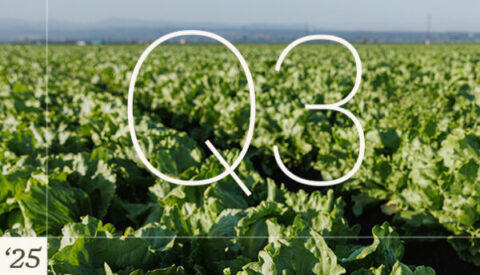U.S. Soybean Supplies Slashed Despite the USDA’s record yield estimate of 53.5 bu./ac. in the September World Agricultural Supply and Demand Estimates (WASDE) report, weather extremes raise uncertainty. Excessive moisture in the western corn belt (raising disease risk) and drought in the East (record-low August rainfall in some states) have created doubts about yields. Thus, traders anticipate future yield cuts, which could tighten the U.S. supply balance sheet further. For now, all eyes are on global supply and demand as harvest begins. The USDA raised total production to 4.301 billion bushels compared with the August WASDE, partially driven by higher planted and harvested acres. Although, it is still down 1.5% from 2024/25. The USDA reports a nearly 10% year-over-year (YOY) decline in ending stocks for 2025/26 compared with 2024/25. Looking ahead to 2026, rising fertilizer costs may shift some acres from corn back to soybeans in portions of the corn belt. If that happens, without stronger domestic or global consumption, this could inflate stocks and pressure prices. For now, all eyes are on global supply and demand as harvest begins. The USDA expects Brazil to export a record 112 MMT, matching China’s projected imports for 2025/26. Brazil’s Bean Bounty Despite a slight reduction in global ending stocks in the September WASDE report, global soybean production remains at record levels — driven largely by Brazil’s forecast of a 175 million metric ton (MMT) soybean crop. While there currently is a range of private estimates floating around (anywhere from 176.5 MMT to 181 MMT), price and weather will ultimately determine Brazil’s final soybean production in 2025/26. Some good news is that Brazil has confirmed it will uphold its soy moratorium, which should limit row crop expansion tied to deforestation. That alone will not stop Brazil from continuing to break soybean production records in the future, given abundant available pastureland. The USDA expects Brazil to export a record 112 MMT, matching China’s projected imports for 2025/26. Brazil and China’s strategic soy partnership began in 2004 with their first direct soybean shipment and has continued to intensify, with aligned supply chain integration and mutual pursuit of sustainability and quality standards. This increasingly sidelines other global suppliers. If Brazil does fully replace U.S. market share to China, the U.S. must pivot toward other buyers, particularly in Southeast Asia, the Middle East and the EU. As Brazil solidifies its dominance as the global soybean supplier, the U.S. faces mounting pressure to defend its market position — especially as competitive pricing alone may not be enough to offset shifting demand and geopolitical headwinds. Soybean Showdown While the U.S. is currently competitively priced, China still dominates global imports and has an outsize impact on U.S. sales. Historically, China consumes 20% to 25% of U.S. production, making full replacement by other markets unlikely. The USDA slightly lowered U.S. export forecasts in the September WASDE, not due to reduced Chinese purchases but rather because of intensifying global competition. China has yet to purchase any 2025/26 U.S. soybeans and maintains a 23% tariff, though it could be waived. Notably, as of September 11, “Unknown” buyers account for nearly 40% of the 10.3 MMT of new-crop soybean total committed sales. Longer term, the U.S. must prepare for a structural decline in China. The current 90-day tariff temporary suspension expires November 10. A positive trade headline could spark a price rally. However, if China continues to avoid U.S. soybeans until January, Brazil’s new soybean harvest will be ready to meet its needs so long as weather cooperates. While executive action can influence China’s future purchases if a trade deal is signed with the U.S., the likelihood of significant new-crop sales to China before year’s end currently appears slim. A trade deal would certainly overrule this outlook in the short term. However, longer term, the U.S. must prepare for a structural decline in China and focus on strengthening trade relationships with other countries for both soybeans and soymeal exports. China’s Contraction China enters the new crop year with record beginning stocks, pushing its stocks-to-use ratio above 30%. Based on actual and forecast swine production and crush activity, I estimate China’s full-year soybean import needs closer to 100 MMT, with a gradual decline, which would increase global stocks and potentially pressure prices. China, the world’s largest pork producer, imports soybeans primarily to crush for swine feed. However, its hog population and pork production have remained flat (following the herd rebuild post-African swine fever in 2018). Changing consumer demographics have led to weaker pork consumption, and thus oversupply, with the Chinese Academy of Agricultural Sciences estimating swine feed consumption at 141 MMT in 2029 (a decline of nearly 1% versus 2024 at 142 MMT). Chinese officials have directed pig breeders to reduce sow counts and pig weights to curb production due to declining demand. The contraction is ultimately driven by China’s aging population, shifting dietary preferences and broader economic challenges. Younger consumers’ protein preference has been chicken and fish, and even older consumers are trading down the protein ladder away from pork, according to a 2025 USDA report. China’s domestic soybean processing profit margins have struggled, as declining food service consumption has reduced soybean oil utilization, according to an October 2025 AMIS Market Monitor report. The likelihood of China’s swine herd expanding, driving record crush, and tying for record soybean imports, as the USDA’s current forecast suggests, is doubtful. Recent purchases of soymeal from Argentina further signal reduced crush (and reduced import soybean needs). While Brazil’s dominance in supplying China grows, other populous nations like India offer limited relief. Despite being the world’s most populous country, India’s consumer dietary habits do not support significant oilseed growth: Nearly 40% are vegetarian, and those who eat protein prefer chicken and fish. This underscores the urgency for the U.S. to diversify soybean and soybean meal export markets while also strengthening domestic utilization in biofuel. U.S. Soybeans: Crush or Be Crushed? U.S. competitiveness continues to experience additional headwinds. Recently, Argentina temporarily eliminated export taxes until the end of October for grain, oilseed and byproducts, which promptly resulted in China purchasing its soybeans, but the break only lasted a few days. Exploring alternative crops for 2026 planting decisions is another potential option to diversify your operation. At the same time, U.S. export logistics are also increasingly complex. Mississippi River barge drafts and tow sizes are being restricted again due to low water levels, which increases transportation costs. New U.S. fees on Chinese-owned, -operated or -built vessels (effective October 14, 2025) will also reduce shipping flexibility and can raise export costs. Oilseed farmers must closely monitor trade developments, especially before the November 10 deadline, as these will drive prices until biofuel policy becomes clear (likely not until spring 2026). Policy headlines often override fundamentals, complicating farmer decision-making. Exploring alternative crops for 2026 planting decisions is another potential option to diversify your operation and hedge against this uncertainty. Closely monitoring Brazil’s weather through its growing season could also present opportunity with their other soybean buyers. While global competition intensifies, the U.S. remains a price leader and has opportunities to expand into new markets. I am hopeful the harvest-low price was set on August 12 following the WASDE report, as prices have not retested those levels. I expect the new-crop average farm price to range between $9.50/bu. to $10.50/bu. I would recommend rewarding any rally (especially if above break-even levels), potentially locking-in prices ahead of delivery given the ongoing uncertainty and cloudy market outlook.
More Articles
See All InsightsSANTA ROSA, Calif., (Nov. 7, 2024) – As key executive leaders transition into retirement in January 2025, American AgCredit has announced 5 updates to its executive…
Lower Sentiment, Lower Lettuce Demand In some ways 2025 has been standard in the lettuce industry. From early March, production shifted from Yuma, Imperial Valley and
A few miles off State Route 79 in Temecula, California, lies a 12-acre patch of paradise known as Robert Renzoni Vineyards. This Riverside County vintner has…



